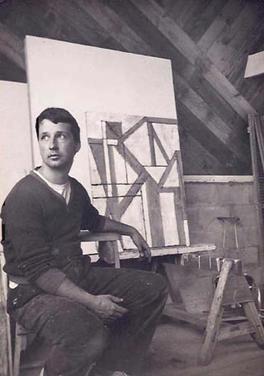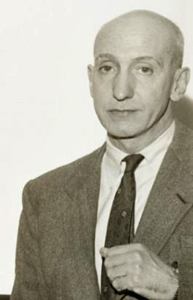Related Research Articles

Lasar Segall was a Lithuanian Jewish and Brazilian painter, engraver and sculptor. Segall's work is derived from impressionism, expressionism and modernism. His most significant themes were depictions of human suffering, war, persecution and prostitution.

Alfredo Volpi, was a prominent painter of the artistic and cultural Brazilian modernist movement. He was born in Lucca, Italy but, less than two years later, he was brought by his parents to São Paulo, Brazil, became a Brazilian citizen, and lived for the majority of his life. He was one of the most important artists of the so-called Grupo Santa Helena, formed in the 1930s with Francisco Rebolo, Clóvis Graciano, Mario Zanini, Fulvio Pennacchi, and others.

John Hamilton Bush was a Canadian abstract painter. A member of Painters Eleven, his paintings are associated with the Color Field movement and Post-painterly Abstraction. Inspired by Henri Matisse and American abstract expressionist painters like Helen Frankenthaler and Morris Louis, Bush encapsulated joyful yet emotional feelings in his vibrant paintings, comparing them to jazz music. Clement Greenberg described him as a "supreme colorist", along with Kenneth Noland in 1984.
Albert Kotin belonged to the early generation of New York School Abstract Expressionist artists whose artistic innovation by the 1950s had been recognized across the Atlantic, including in Paris. The New York School Abstract Expressionism, represented by Jackson Pollock, Willem de Kooning, Franz Kline, and others became a leading art movement of the post-World War II era.
Jan Müller was a New York-based figurative expressionist artist of the 1950s. According to art critic Carter Ratcliff, "His paintings usually erect a visual architecture sturdy enough to support an array of standing, riding, levitating figures. Gravity is absent, banished by an indifference to ordinary experience." According to the poet John Ashbery, Müller "brings a medieval sensibility to neo-Expressionist paintings."
Ernest P. Briggs Jr. (1923–1984) was a second-generation Abstract Expressionist painter known for his expressive, sometimes calligraphic brushwork, his geometric compositions, and revolution in abstract painting that secured New York City's position as the art capital of the world in the post-World War II period.

American Figurative Expressionism is a 20th-century visual art style or movement that first took hold in Boston, and later spread throughout the United States. Critics dating back to the origins of Expressionism have often found it hard to define. One description, however, classifies it as a Humanist philosophy, since it's human-centered and rationalist. Its formal approach to the handling of paint and space is often considered a defining feature, too, as is its radical, rather than reactionary, commitment to the figure.

Fritz Bultman was an American abstract expressionist painter, sculptor, and collagist and a member of the New York School of artists.
Lester Johnson was an American artist and educator. Johnson was a member of the Second Generation of the New York School during the late 1950s. The subject of much of his work is the human figure. His style is considered by critics and art historians to be in the figurative expressionist mode.
Walter Kuhlman (1918–2009) was a 20th-century American painter and printmaker. In the late 1940s and 1950s, he was a core member of the San Francisco School of Abstract Expressionism. He later worked in a representational style related to American Figurative Expressionism.
Roland Conrad Petersen is a Danish-born American painter, printmaker, and professor. His career spans over 50 years, primarily in the San Francisco Bay Area and is perhaps best-known for his "Picnic series" beginning in 1959 to today. He is part of the Bay Area Figurative Movement.
City Gallery was an art gallery in New York City that exhibited the work of contemporary artists in a loft space that was run collectively by a group of young avant-garde artists.
Robert Goodnough was an American abstract expressionist painter. A veteran of World War II, Goodnough was one of the last of the original generation of the New York School;, even though he began exhibiting his work in galleries in New York City in the early 1950s. Robert Goodnough was among the 24 artists from the total of 256 participants who were included in the famous 9th Street Art Exhibition, (1951) and in all the following New York Painting and Sculpture Annuals from 1953 to 1957. These Annuals were important because the participants were chosen by the artists themselves. Early in his career starting in 1950 he showed his paintings at the Wittenborn Gallery, NYC. He had shown at the Tibor de Nagy Gallery in New York City from 1952 to 1970 and again from 1984 to 1986. In 1960 and 1961 he had solo exhibitions at The Art Institute of Chicago. A veteran of scores of solo exhibitions and hundreds of group exhibitions in the United States and abroad, Goodnough also had solo exhibitions in 1969 at the Whitney Museum of American Art in NYC and the Albright-Knox Art Gallery in Buffalo. A major work by Goodnough is included in The Governor Nelson A. Rockefeller Empire State Plaza Art Collection in Albany, NY. In later years his paintings were also associated with the Color Field movement.
Nanno de Groot was a self-taught artist. He belonged to the group of New York School Abstract expressionist artists of the 1950s. He wrote:
In moments of clarity of thought I can sustain the idea that everything on earth is nature, including that which springs forth from a man's mind, and hand. A Franz Kline is nature as much as a zinnia.
Robert Beauchamp was an American figurative painter and arts educator. Beauchamp's paintings and drawings are known for depicting dramatic creatures and figures with expressionistic colors. His work was described in the New York Times as being "both frightening and amusing,". He was a Guggenheim Fellow and a student of Hans Hofmann.

Karl Knaths was an American artist whose personal approach to the Cubist aesthetic led him to create paintings which, while abstract, contained readily identifiable subjects. In addition to the Cubist painters, his work shows influence by Paul Cézanne, Wassily Kandinsky, Utagawa Kuniyoshi, Paul Klee, Stuart Davis, and Agnes Weinrich. It is nonetheless, in use of heavy line, rendering of depth, disciplined treatment of color, and architecture of planes, distinctly his own.

George McNeil was an American abstract expressionist painter.
Marcia Grostein Marcia Grostein is a Brazilian-American artist known for using various mediums across public art, sculpture, painting, video art, photography, and portable wearable art/jewelry. She was the first contemporary Brazilian artist to be acquired by the Metropolitan Museum of Art for the 20th Century Collection by the curator Lowery Sims.
Grupo Ruptura was created by a collection of artists who sought to advance modern art in Brazil in the 1950s. Together, they held an exhibition entitled Ruptura at the São Paulo Museum of Modern Art in 1952. The group embraced concrete art as a break from traditional naturalistic painting popular in Brazil at the time. Grupo Raptura's works are often characterized by strong geometric shapes and bold colors.
Tikashi Fukushima was a Japanese-Brazilian painter and printmaker. Considered one of the most important abstractionists in Brazil, Fukushima also produced several works in the field of figurativism throughout his career. The artist has received various positive reviews from numerous important art critics for both his abstractionist and figurative productions. Fukushima belongs to the pre-war immigrant generation, composed of common immigrants who, after several changes in their lives, awakened to the arts. His master was Tadashi Kaminagai, whom Fukushima saw as a mentor, but who had a different style of painting than the one he later developed. Tikashi's works have been presented in national and international exhibitions.
References
- ↑ Raynor, Vivien (1994-03-13). "ART; Similarities Despite Radically Different Styles". The New York Times. ISSN 0362-4331 . Retrieved 2022-12-05.
- ↑ Zucker, Adam. Figurative Expressionist Jay Milder: Unblotting the Rainbow. Berkshire Fine Arts, November 20, 2014. http://www.berkshirefinearts.com/11-20-2014_figurative-expressionist-artist-jay-milder.htm
- 1 2 Claudia (2017-04-06). "Jay Milder, a Figurative Expressionist". The Brasilians. Retrieved 2021-02-18.
- ↑ Zucker, Adam. Jay Milder Recent Work. Berkshire Fine Arts, October 21, 2009. http://www.berkshirefinearts.com/?page=article&article_id=1294&catID=3
- ↑ Panero, James. Gallery Chronicle.The New Criterion, November 2009. http://www.newcriterion.com/articles.cfm/Gallery-chronicle-4327#fn2
- 1 2 3 Stein, Judith (1991). "Jay Milder, Urban Visionary." In Jay Milder, Urban Visionary: Retrospective 1958-1991, New England Center for Contemporary Art, 1991. https://judithestein.com/1991/01/01/jay-milder-urban-visionary/
- ↑ "Hall of Fame | Class of 1952: Jay Milder". The Central High School Foundation. Retrieved 2022-12-04.
- 1 2 3 Zucker, Adam (2019). Jay Milder: Unblotting the Rainbow. Provincetown, MA: Provincetown Art Association and Museum.
- ↑ Goodrich, John (2006-05-04). "Lives on Canvas". The New York Sun.
- ↑ Zucker, Adam. "Re-Introducing The Rhino Horn Group - Adam Zucker - Berkshire Fine Arts". www.berkshirefinearts.com. Retrieved 2022-12-03.
- 1 2 Morgan, Robert C. Jay Milder. The Brooklyn Rail, June 2006. http://www.brooklynrail.org/2006/06/artseen/jay-milder
- ↑ "G1 > Edição São Paulo - NOTÍCIAS - Grafiteiro americano de 75 anos pinta muro em São Paulo".
- ↑ Nelson Preston, George (November 1976). "Jay Milder: Painter of Discovery, Resolution and Rediscovery". Arts. p. 89.
- ↑ Kuspit, Donald. “Jay Milder at Richard Green Gallery” Art Forum, December 1987. p 111. ill.
- ↑ "Milder.2179.Pa13 | PAAM". 2014-12-18. Retrieved 2022-12-04.
- ↑ "Two Faces". chrysler.emuseum.com. Retrieved 2022-12-04.
- ↑ "Subway Faces | RISD Museum". risdmuseum.org. Retrieved 2022-12-04.